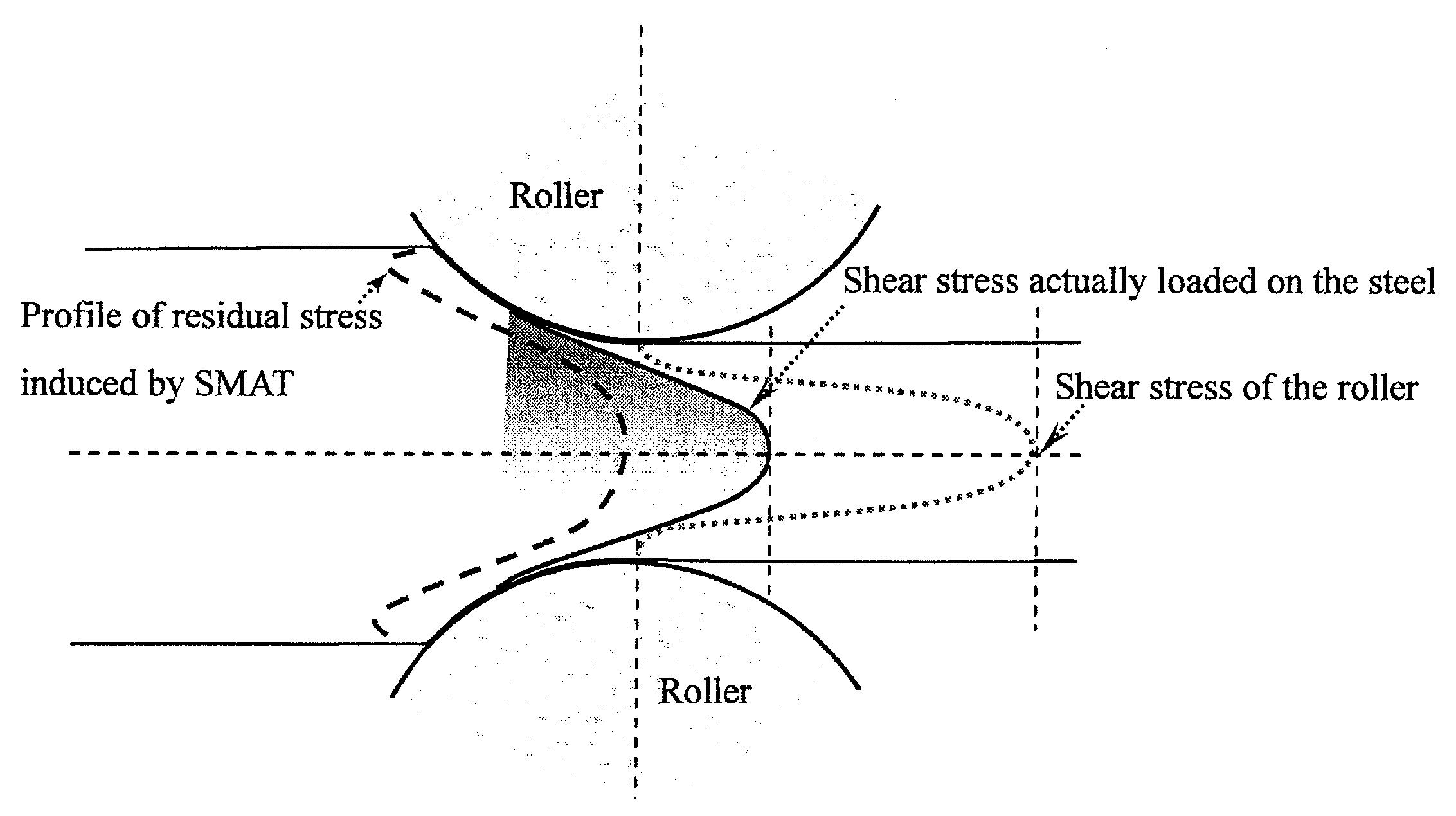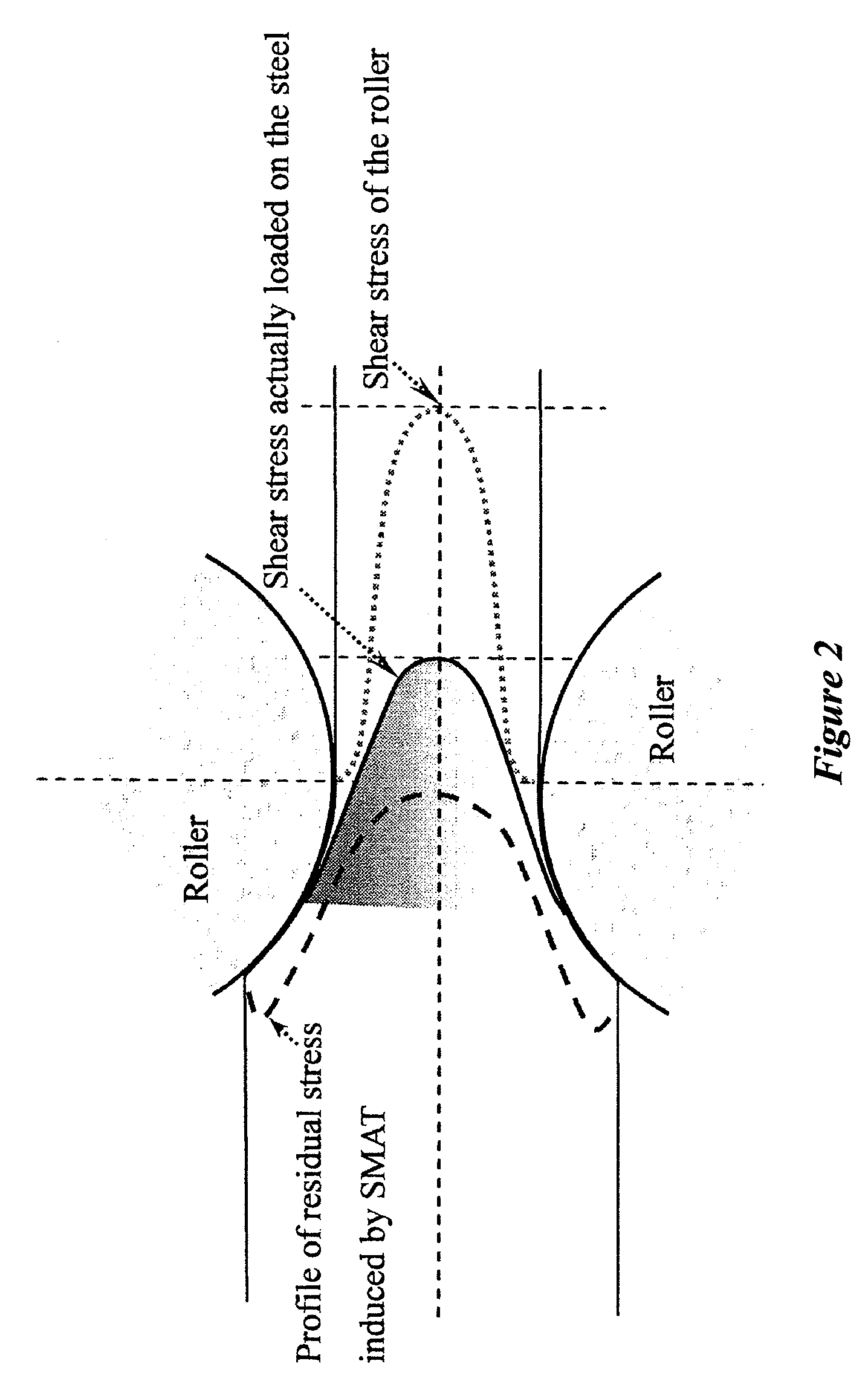Nanostructured austenitic steel and method of making nanostructured austenitic steel
a technology of nanostructured austenitic steel and austenitic steel, which is applied in the field of nanostructured austenitic steel and to a method of making nanostructured austenitic steel, can solve the problems of difficult production of refined austenite, and achieve the effects of high strength, large ductility and work hardening ability
- Summary
- Abstract
- Description
- Claims
- Application Information
AI Technical Summary
Benefits of technology
Problems solved by technology
Method used
Image
Examples
example 1
[0031]AISI 304 stainless steel sheet with thickness of 1 mm was subjected to surface mechanical attrition treatment (SMAT) to obtain nanocrystalline martensite. The duration of SMAT was 15 minutes using ceramic balls with vibration frequency of 20 KHz. The SMATed sheet was heated to 600 degrees-C. for 30 minutes, and warm rolled at 600 degrees-C. with a 60% area reduction to a thickness of 0.4 mm in single pass. The exit surface temperature of the sheet from the rollers was 580 C. The sheet was then left to cool in air to ambient temperature the internal stress during deformation was schematically shown in FIG. 2.
[0032]The microstructure of the SMATed sheet was composed of nanocrystalline martensite, twin austenite, and deformed austenite with dislocation cell and tangles. FIGS. 3A and 3B show that the phase content of martensite originated from the strain-induced martensite transformation by SMAT was about 100% and 55% in the surface, and 80 μm depth, respectively. The compressive ...
example 2
[0033]AISI 304 stainless steel sheet with thickness of 1 mm after solution treatment at 1050 C for 40 minutes was subjected to SMAT with stainless steel balls at a frequency of 50 Hz for 60 minutes. The SMATed sheet was heated to 550 degrees-C. for 20 minutes and warm co-rolled at 500 degrees-C. for an area reduction of 50% to a thickness of 0.5 mm in a single pass. The exit surface temperature of the sheet from the rollers was 470 C. The sheet was then left to cool in air to ambient temperature.
[0034]The microstructure of the produced sheet was composed mainly of nanocrystalline austenite and deformed austenite 35% and 30% by volume fraction, respectively. FIG. 5 shows that the microhardness of the subsurface in the nanostructured austenite steel was high up to about 400 HV two times of the matrix 304ss. The yield strength was high up to 692 MPa, which increased 140% that of the matrix (288 MPa). FIG. 6 shows that the elongation to fracture was about 38.5%, together with the unifor...
example 3
[0035]AISI 304 stainless steel sheet with thickness of 2 mm was subjected to SMAT with stainless steel balls at a vibration frequency of 50 Hz for 60 minutes. The SMATed sheet was heated to 700 C for 10 minutes, and warm rolled at 700 degrees-C. for an area reduction of 30% to a thickness of 1.4 mm in a single pass. The exit surface temperature of the sheet from the rollers was 650 degrees-C. The sheet was then water cooling to ambient temperature.
[0036]The microstructure of the produced sheet was primarily composed of nanocrystalline austenite, twin austenite, and deformed austenite with dislocation cell. The grain size of the austenite less than 100 nm reached depth of 100 μm, and less than 5 μm in the centre zone. The phase content of nanocrystalline austenite from reverse transformation of nanocrystalline martensite was about 30%. Twin austenite and austenite with dislocation cells were also observed in the produced steel. The observations of microstructure show that the grain s...
PUM
| Property | Measurement | Unit |
|---|---|---|
| Grain size | aaaaa | aaaaa |
| Length | aaaaa | aaaaa |
| Fraction | aaaaa | aaaaa |
Abstract
Description
Claims
Application Information
 Login to View More
Login to View More - R&D
- Intellectual Property
- Life Sciences
- Materials
- Tech Scout
- Unparalleled Data Quality
- Higher Quality Content
- 60% Fewer Hallucinations
Browse by: Latest US Patents, China's latest patents, Technical Efficacy Thesaurus, Application Domain, Technology Topic, Popular Technical Reports.
© 2025 PatSnap. All rights reserved.Legal|Privacy policy|Modern Slavery Act Transparency Statement|Sitemap|About US| Contact US: help@patsnap.com



